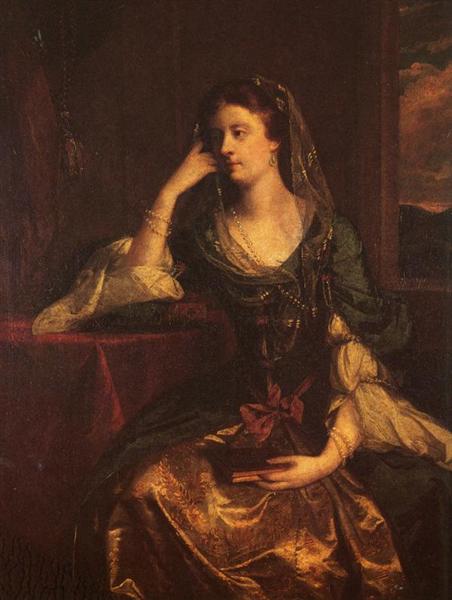Opis
The painting “Emily, Duchess of Leinster”, created in 1753 by Joshua Reynolds, is a magnificent example of 18th-century aristocratic portraiture, a period in which painting became a crucial vehicle for the representation of social status and personal identity. Reynolds, a leading portrait painter of his time and president of the Royal Academy, specialised in capturing not only the appearance of his sitters but also their character and presence, something that is clearly evident in this work.
The Duchess is presented in an intimate and elegant composition that reveals both her status and her personal grace. The central figure of the painting is dressed in an elaborate, flowing white silk outfit, in which the artist has managed to capture the texture and sheen of the material with impressive subtlety. Around her, a background curtain in a shade of blue-grey enriches the composition, creating a subtle contrast that makes the Duchess’ figure stand out even more. This use of colour is characteristic of Reynolds, who possessed a sophisticated palette that allowed him to create atmospheres of warmth and depth. The choice of a relatively neutral background compared to the luminous dress further highlights the subject.
The Duchess is depicted in a relaxed pose, resting one of her arms on a pillow, suggesting both an inherent confidence and an approachability that may be rare in portraits of her period. Her direct gaze is on the viewer, establishing a personal and almost intimate connection, challenging the rigid conventions of her social status. The care with which her facial features have been rendered, particularly her bright eyes and slight smile, conveys a sense of dynamism, offering a glimpse of the personality behind the noble title.
A fascinating detail of Reynolds' techniques is his use of chiaroscuro. The lighting in the painting accentuates the Duchess's features, illuminating her face while the shadows are softly distributed to provide volume and three-dimensionality. This play of light and shadow adds an almost painterly dimension to the figure, inviting viewers to appreciate the complexity of the portrait not only as a representation, but as an aesthetic experience.
The portrait of the Duchess of Leinster also shows a dialogue with other works by contemporary portrait painters, such as Thomas Gainsborough, who tended to use landscape backgrounds and more vibrant tones in his portraits. Unlike Gainsborough, Reynolds adheres to a more classical aesthetic, using a more restrained composition and a more subtle palette, which reinforces the social discrimination and glamour associated with the nobility of the time.
Although there are few documented details about the life of Emily, Duchess of Leinster, this work can also be understood as a reflection of the social aspirations of the 18th century, where portraits were not only a way of immortalising the figure of a noblewoman but also a way of solidifying her family legacy. The Duchess, as an object of Reynolds' artistic practice, not only becomes a symbol of the elegance and refinement of her time, but at the same time, her timeless representation conveys the durability of art as a means of connecting the past and the present.
In conclusion, “Emily, Duchess of Leinster” is not just a portrait in the traditional sense, but a masterpiece that combines Reynolds’ technical mastery with a deep understanding of the psychology of portraiture. Her ability to capture the essence of her subject while remaining within the conventions of her time ensures this painting a prominent place in the history of British art and in the evolution of portraiture.
KUADROS ©, a famous painting on your wall.
Hand-made oil painting reproductions, with the quality of professional artists and the distinctive seal of KUADROS ©.
Painting reproduction service with satisfaction guarantee. If you are not completely satisfied with the replica of your painting, we will refund 100% of your money.

